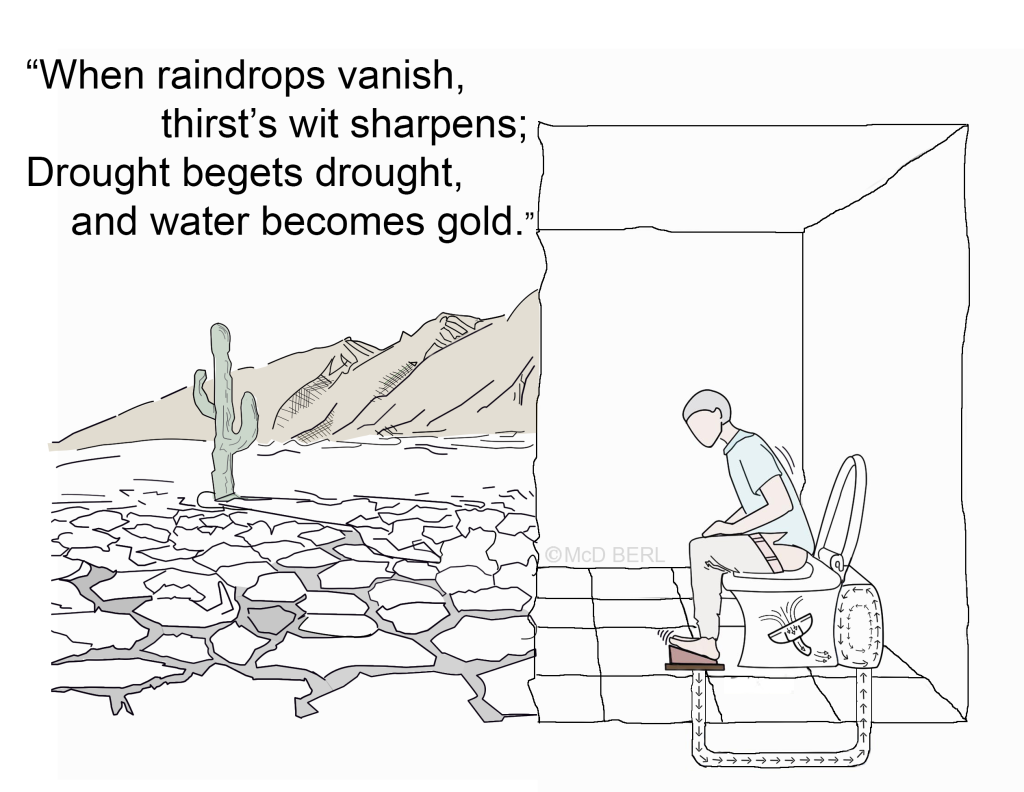Restless Rooms

Concept: This image shows the use of vacuum flush. A kind of flush that requires
a minimal amount of water, similar to flushes in an aircraft. A person can sit on
the toilet and continue the due business as regular. While on the seat, he presses
the lever on the floor with his feet creating a vacuum. After he’s done, he can
press the flush button, but instead of a full water flush, the flush will be mostly
vacuum and partially water.
A New Kind of Black Hole
“There’s a black hole, hiding within the construction industry, and it wants water.
Lots and lots of water. And, it’s never satiated…”
Apartments, buildings, and all kinds of medium to large-scale man-made
infrastructures are designed to last for decades if not centuries. Building them
requires 10s of millions of liters of water, and over their entire lifetime, they
might consume even more water than they initially demanded.
There are hundreds of millions of such large infrastructures in the world and they
all are consuming inconceivable amounts of water 24 x 7, 365 days and they will
continue to do so for their entire lifetime. So, what happens to all the water they
consume? Where does it go?
Following the victim: Water
In our previous featured article, Environmentally Intelligent Urinals, we briefly explored how clean water is a necessity not just for drinking purposes, but also for construction. You cannot construct strong and lasting buildings using polluted and contaminated water. And after the building is constructed, you’ll require clean water for drinking, cleaning, flushing, and showering. Let’s track the journey of water further.
Generally speaking, the water that is consumed during the construction
process is lost forever in the concrete and the physical structure of the building.
There are ways to conserve that water but it is a net-negative process and we
can’t do much about it, but there are other ways we can save water.
What happens to the water after showers, cooking, cleaning, and human waste?
Below is a chart of how long it takes for the used water to come back from its
respective source. It is called Water Residence Time
For instance, after you take a shower, if the water goes to the ground through
drains it will take 10,000 years for it to come back. And if it goes to the ocean
through the rivers, it will take 3,200 years for it to come back.
With the water crisis rising dramatically in many parts of the world, this problem
is not going to be laid on a particular demographic. This will soon become a
universal problem. The decision might be between either stopping drinking
water or stopping construction. Unless we do something about it.
Saving the victim: Water
What can we do to achieve water self-sustainability? What are some ways to
create a net-positive water world? We can do plenty to conserve, reuse and
recycle water during the entire lifetime of a building. Here are some ways:
1. Human activity: Day-to-day water usage can be optimized in various ways
such as dual flush, low-flow showerheads, sensor taps, etc.
2. Rainwater storage & harvesting: This is a very easy way to conserve a lot of
water and become water self-sustainable. Instead of letting the water run
off, we can store it and use it.
3. Greywater recycling: A method in which water is collected from
washbasins, washing machines, and showers and is recycled for the same
usage.
4. Recharge groundwater via water spreading, percolation tank or basin, dug
well recharge, recharge pit, injection wells, and more
At Mcd BERL, we focus on sustainable development because we care for our
future. We offer sustainable engineering solutions and MEP services to build
net-positive energy and net-positive water buildings that can reduce CAPEX by
3% & OPEX by 30-50%. Click here to talk about your project




